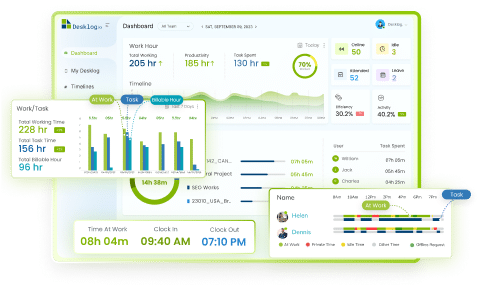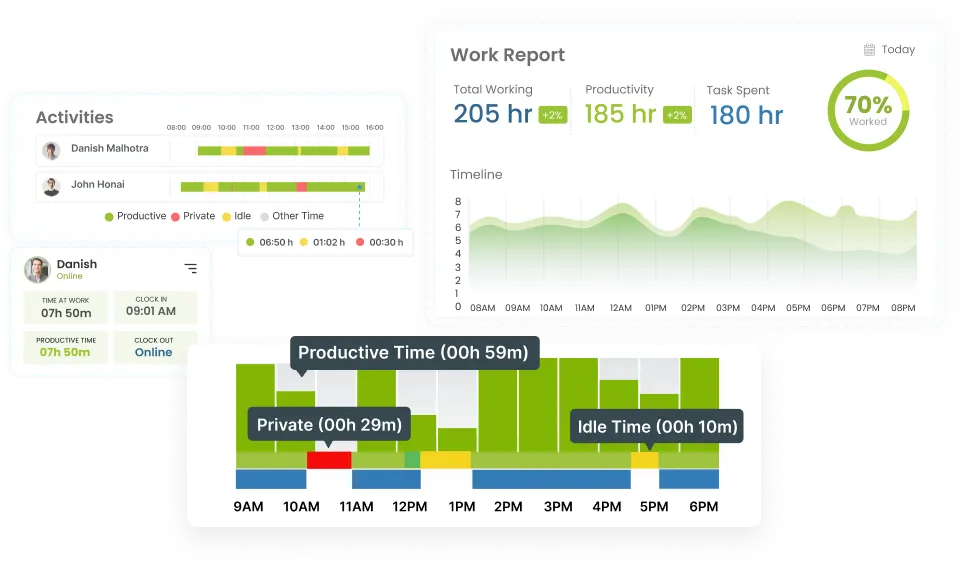Traditional project management often involves a detailed plan upfront, like finalizing all the features for a software application before any coding begins.
Agile approaches development differently. For example, you are building a software product. With Agile, you’d start with a core set of features and build them in small increments. After each increment, you’d gather feedback from stakeholders (the “owners”) and see if they like the direction or want adjustments. This iterative process allows for flexibility and ensures the final product aligns with evolving needs. It’s like building in small steps, getting feedback, and refining the product continuously to achieve the desired outcome.
What is Agile methodology?
Agile methodology is a modern way of developing software that focuses on teamwork, adaptability, and customer satisfaction. Usage of this methodology has been revolutionizing project management experiences.
At the heart of Agile are four key values:
- prioritizing people and interactions
- focusing on working software
- collaborating with customers
- being open to change.
These values guide principles that emphasize delivering valuable software quickly, embracing changes, and encouraging team communication and motivation. Agile helps teams create software that meets customer needs effectively and evolves with their requirements.
Kanban vs. Scrum: What’s the difference?
Choosing between Kanban vs Scrum depends on your project’s needs and your team’s preferences. But it’s essential to know the difference between Kanban vs scrum to decide which fits you the best.
Kanban
Kanban is a visual workflow management method used to improve efficiency and productivity, particularly in software development and manufacturing. It originated from the Toyota Production System (TPS) and was later adapted by software development teams seeking a more flexible approach to project management. Additionally,you can make use of the kanban view provided by time tracking and project management softwares.
Kanban revolves around two key principles: workflow visualization and Work In Progress (WIP) limits.
Workflow Visualization
Kanban visualizes the entire workflow of a project, from start to finish, using a Kanban board. A Kanban board is divided into columns representing different stages of the workflow, such as “To Do,” “In Progress,” and “Done.” Each task or work item is represented by a card, which moves through the columns as it progresses toward completion. By visualizing the workflow, teams gain a clear understanding of the status of each task. WIP Limits: WIP limits, or Work In Progress limits, restrict the number of tasks that can be in progress at any given time in each stage of the workflow. By setting WIP limits, teams aim to prevent overloading any particular stage of the workflow, which can lead to inefficiencies and delays. WIP limits encourage teams to focus on completing tasks before starting new ones, thereby reducing multitasking and improving overall flow.
Sprints
They are short work cycles, usually lasting 1-4 weeks, where a team works together to finish a part of a project. This helps them focus on important tasks and deliver something usable quickly. After each sprint, the team reviews what they’ve done and looks for ways to do better next time.
Read more : Pros and Cons of Kanban
Scrum
Scrum methodology is a way of project management that focuses on teamwork and adaptability. It breaks work into short periods called sprints, typically lasting a few weeks.
The core elements of Scrum include sprints, roles, and ceremonies:
WIP Limits
WIP limits, or Work In Progress limits, restrict the number of tasks that can be in progress at any given time in each stage of the workflow. By setting WIP limits, teams aim to prevent overloading any particular stage of the workflow, which can lead to inefficiencies and delays. WIP limits encourage teams to focus on completing tasks before starting new ones, thereby reducing multitasking and improving overall flow.
Roles: Scrum defines three core roles within the framework
Product Owner
They decide what’s most important to do next, manage the list of things to do, and choose when to release new features. They work closely with the team to make sure the product meets what customers want and what the business needs.
Scrum Master
The Scrum Master is a guide for the team. They help remove any obstacles the team might face, encourage everyone to work together well, and make sure the team follows the rules of Scrum. The Scrum Master also organizes and leads important meetings to make sure they’re helpful and get things done.
Development Team
The Development Team is the group that actually makes the product during each sprint. They work together to create, test, and deliver usable software. They organize themselves and use their different skills to get the job done. They follow the direction of the Product Owner and aim to meet the goals of each sprint while making sure the product they create is top-notch..
Ceremonies
Scrum defines several ceremonies or events to facilitate communication, collaboration, and transparency within the team:
Sprint Planning
At the start of each sprint, the team gathers to decide what they’ll work on. The Product Owner shares the most important tasks from the list, and together, they set a goal for the sprint and make a plan for what to do.
Daily Stand-up (Daily Scrum)
Every day during the sprint, the team has a quick meeting to update each other. They talk about what they’ve done, what they’re doing next, and if there are any problems. This helps everyone stay on the same page and solve issues quickly.
Sprint Review
When the sprint is done, the team shows what they’ve completed to the stakeholders. The Product Owner checks if everything is as expected and talks about any changes needed for future tasks. It’s a chance for stakeholders to give feedback and make sure the product is on track.
Sprint Retrospective
After the sprint review, the team talks about how things went. They discuss what went well, what could’ve been better, and what they’ll do differently next time. It’s about learning from mistakes and making improvements for the next sprint.
You can make use of agile and scrum management to get your products to market faster and track project progress.This aids in boosting employee productivity,
Deciding between Kanban vs Scrum will ultimately come down to your specific project needs and team preferences. Each method offers unique benefits that can be aligned with your organizational goals for maximum efficiency and productivity. For more insights into Kanban vs Scrum, consider evaluating how each approach can be tailored to fit your workflow and project requirements.
To evaluate you need to know the pros and cons of kanban and scrum, here’s an overview.
Pros & cons of kanban and scrum
| Aspect | Kanban | Scrum |
|---|---|---|
| Pros | ||
| Workflow Flexibility | Provides flexibility in handling changes and adapting to varying workloads. | Offers structured roles and ceremonies, ensuring clarity and focus. |
| Continuous Delivery | Enables continuous delivery of work items, leading to faster value delivery. | Facilitates regular release cycles through time-boxed iterations. |
| Visualization | Offers clear visualization of work stages and bottlenecks, aiding in workflow management. | Provides transparency through defined roles, events, and artifacts. |
| Minimal Overhead | Requires minimal setup and overhead, making it suitable for smaller teams and projects. | Provides a comprehensive framework with defined roles and processes, offering guidance for project management. |
| Scalability | Easily scalable to different teams and projects without significant adjustments. | May require more effort to scale to larger teams or complex projects. |
| Cons | ||
| Lack of Structure | Can lack the structure and guidance provided by Scrum, potentially leading to ambiguity. | The structured nature may feel restrictive to some teams, especially those seeking more flexibility. |
| Limited Planning | May not offer as robust planning capabilities as Scrum, making it challenging to forecast delivery timelines. | Requires disciplined adherence to roles and ceremonies, which may not suit every team’s workflow. |
| Risk of Overload | Without WIP limits, there’s a risk of overloading the team with too much work, leading to inefficiencies. | The pressure of completing work within sprint deadlines may result in burnout or rushed deliverables. |
| Dependency on Visualization | Relies heavily on visualizing work stages, which may be challenging for teams without adequate tools or processes. | Requires active participation and collaboration from all team members, which may be difficult to achieve in some environments. |
Difference between kanban vs scrum
| Aspect | Scrum | Kanban |
|---|---|---|
| Process | Divides work into sprints. | Continuous; focuses on flow and visualizing the workflow. |
| Sprints | Time-boxed iterations, usually lasting 1-4 weeks. | No fixed time-box for work cycles; tasks flow continuously. |
| Ceremonies | Sprint planning, daily stand-ups, sprint review, retrospective. | No prescribed ceremonies; may use daily stand-ups or regular reviews. |
| WIP Limits | Optional; commonly used to manage work in progress. | Not a core component; optional but can be implemented. |
| Strengths | Structured framework, regular release cycles, clear roles. | Flexibility, continuous flow, adaptive to changes. |
| Weaknesses | Can feel rigid for some teams, requires discipline and adherence. | May lack structure for larger projects, potential for overload. |
Kanban vs Agile
Kanban and Agile are both methodologies used in project management, but they differ in their approaches and focus.
In simple words, Agile is like a big idea about flexible and collaborative project management. It has different methods like Scrum.
Kanban is one of those methods. It’s about visualizing work, limiting how much is done at once, and keeping things flowing smoothly.
So, Agile is the big picture, and Kanban is one of the ways to make it happen.
Let me explain a little more in depth about it.
Agile is a philosophy emphasizing flexibility, collaboration, and customer satisfaction through iterative development. It’s guided by the Agile Manifesto and utilizes methodologies like Scrum and Extreme Programming (XP) for project management and software development.
Kanban, a method within Agile, focuses on visualizing workflow, limiting work in progress, and optimizing workflow. Originating from lean manufacturing, Kanban emphasizes continuous delivery and efficiency by visualizing work on a board, setting work in progress limits, and managing flow based on demand.
Explain about Kanban vs waterfall
Kanban and Waterfall are two different approaches to project management, each with its own set of principles and practices.
Kanbanis a flexible and continuous method for managing work. It emphasizes visualizing workflow, limiting work in progress, and optimizing the flow of work. Kanban is adaptive and focuses on responding to changes quickly. It allows teams to work on tasks as needed, without being constrained by fixed time frames or rigid structures. Teams using Kanban track their work on a visual board and move tasks through different stages until they are completed.
Waterfall, on the other hand, is a sequential and rigid method for project management. It follows a linear progression of stages, with each stage completed before moving on to the next. In Waterfall, the entire project is planned upfront, and changes are difficult to accommodate once the project is underway. This method is more traditional and works well for projects with clear requirements and stable environments
Kanban Vs Scrum : Which Should I Choose?
Deciding between Kanban vs Scrum depends on factors like the nature of your project, team dynamics, and organizational goals.
Here’s a breakdown
When to Use Kanban
Use Kanban when your project requires flexibility and continuous delivery.
When the project’s requirements are constantly changing or evolving.
When you want to focus on visualizing and optimizing workflow.
When you have a stable team with varying workloads.
When you prefer a more fluid approach without fixed time frames or structured ceremonies.
When to Use Scrum
Use Scrum when you have a well-defined project scope and fixed time frames.
When you want to work in fixed iterations or sprints.
When you need structured roles, ceremonies, and clear deliverables.
When you prioritize collaboration and frequent communication within the team.
When you’re looking for a comprehensive framework with defined practices.
Scrumban
Scrumban is a hybrid approach that combines elements of both Kanban and Scrum.
Use Scrumban when you want the flexibility of Kanban with the structure of Scrum.
When your project requires both continuous delivery and fixed iterations.
When you’re transitioning from one method to another and want to find a middle ground.
When you need to adapt quickly to changing project requirements while still maintaining some level of structure.
Ultimately, the choice between Kanban, Scrum, or Scrumban depends on your project’s specific needs, team preferences, and organizational culture. Consider experimenting with different approaches to find the one that works best for you.
Whether you choose Scrum or Kanban for your Agile project, time tracking software can be a game-changer.Project time tracking provides real-time insights into task durations. This allows you to monitor progress, identify roadblocks that could delay your project, and make adjustments to stay on schedule. Additionally, by tracking past time spent on tasks, you can gain valuable data to make more accurate estimates for future projects. This not only improves efficiency but also fosters accountability within your team, ensuring everyone stays focused and project resources are used effectively.
Conclusion
In conclusion, choosing between Kanban and Scrum depends on various factors such as project requirements, team dynamics, and organizational goals. Kanban offers flexibility and continuous delivery, making it suitable for projects with evolving requirements and varying workloads. On the other hand, Scrum provides structure and clarity, making it ideal for projects with well-defined scopes and fixed time frames.
But wait, there’s more! If you’re feeling adventurous, why not try out Scrumban? It’s like a fusion of the best of both worlds, offering the flexibility of Kanban with the structure of Scrum. It’s the ultimate power-up for teams looking to strike the perfect balance between agility and organization.
So, whether you’re beginning on a grand adventure or tackling a tricky project, remember that the choice is yours. By picking the right Agile framework, you’ll not only set yourself up for success but also discover the full potential of your team. So go ahead and choose wisely!
FAQ
1What is Agile?
Agile is a modern way of working together on projects. It’s all about being flexible, collaborating well, and making sure customers are happy by improving things bit by bit.
2What is Kanban?
Kanban is like a visual to-do list. You put tasks on cards and move them through different stages, like “to do,” “doing,” and “done.” It helps teams see what needs to be done and stay organized.
3What is Scrum?
Scrum is a teamwork method where you work in short bursts called sprints. You plan what to do, work on it, and then review and improve for the next sprint.
4When should I use Kanban?
Use Kanban when your project needs to be flexible and things might change a lot. It’s great for managing tasks and keeping work flowing smoothly.
5When should I use Scrum?
Use Scrum when you have a clear idea of what needs to be done and want to work in short, focused bursts. It’s good for teams who like structure and deadlines.
5What is Scrumban?
Scrumban is a mix of Kanban and Scrum. It gives you the flexibility of Kanban with the structure of Scrum. It’s great for teams who want the best of both worlds.
5Which one should I choose: Kanban or Scrum?
It depends on your project and team. If you need flexibility, go for Kanban. If you like structure and deadlines, go for Scrum. You can also try Scrumban if you want to mix things up!
















